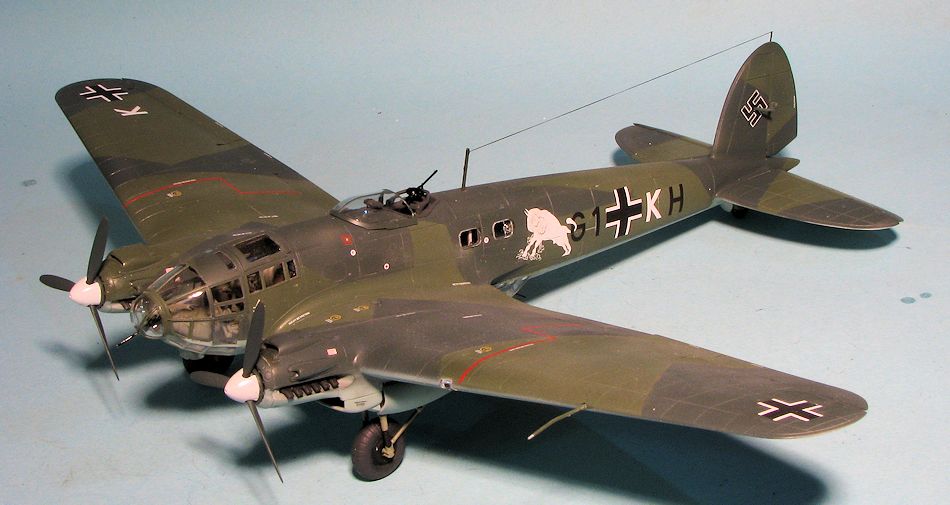
| KIT #: | A06014 |
| PRICE: | $29.98 SRP |
| DECALS: | Two options |
| REVIEWER: | Scott Van Aken |
| NOTES: |
New tool kit |

| HISTORY |
The
He 111P incorporated the
updated Daimler-Benz DB 601A-1 liquid-cooled engine and featured a newly
designed nose section, including an asymmetric mounting for an MG 15 machine gun
that replaced the 'stepped' cockpit with a roomier and more aerodynamic glazed
stepless cockpit
over the front of the aircraft. This smooth glazed nose was first tested on the
He 111 V8 in January 1938. These improvements allowed the aircraft to reach
475 km/h (295 mph) at 5,000 m (16,400 ft) and a cruise speed of 370 km/h
(230 mph), although a full bomb load reduced this figure to 300 km/h (190 mph).
The design was implemented in 1937 because pilot reports indicated problems with
visibility. The pilot's seat could
 actually be elevated, with the pilot's eyes
above the level of the upper glazing, complete with a small pivoted windscreen
panel, to get the pilot's head above the level of the top of the "glass tunnel"
for a better forward view for takeoffs and landings. The rear-facing dorsal gun
position, enclosed with a sliding, near-clear view canopy, and for the first
time, the ventral Bodenlafette
rear-facing gun position, immediately aft of the bomb bay, that replaced the
draggy "dustbin" retractable emplacement became standard, having been first
flown on the He 111 V23, bearing civil registration D-ACBH.
actually be elevated, with the pilot's eyes
above the level of the upper glazing, complete with a small pivoted windscreen
panel, to get the pilot's head above the level of the top of the "glass tunnel"
for a better forward view for takeoffs and landings. The rear-facing dorsal gun
position, enclosed with a sliding, near-clear view canopy, and for the first
time, the ventral Bodenlafette
rear-facing gun position, immediately aft of the bomb bay, that replaced the
draggy "dustbin" retractable emplacement became standard, having been first
flown on the He 111 V23, bearing civil registration D-ACBH.
One of Heinkel's rivals, Junkers, built 40 He 111Ps at Dessau. In October 1938, the Junkers Central Administration commented:
Apparent are the externally poor, less carefully designed components at various locations, especially at the junction between the empennage and the rear fuselage. All parts have an impression of being very weak.... The visible flexing in the wing must also be very high. The left and right powerplants are interchangeable. Each motor has an exhaust-gas heater on one side, but it is not connected to the fuselage since it is probable that ... the warm air in the fuselage is not free of carbon monoxide (CO). The fuselage is not subdivided into individual segments, but is attached over its entire length, after completion, to the wing centre section. Outboard of the powerplants, the wings are attached by universal joints. The latter can in no way be satisfactory and have been the cause of several failures.
The new design was powered by the DB 601 Ba engine
with 1,175 PS The first production aircraft reached Luftwaffe units in Fall
1938. In May 1939, the P-1 and P-2 went into service with improved radio
equipment. The P-1 variant was produced with two DB 601Aa powerplants of
1,150 hp (860 kW). It had self-sealing fuel tanks. The P-1 featured a
semi-retractable tail wheel to decrease drag. Armament
 consisted of a MG 15 in
the nose, and a sliding hood for the fuselage's dorsal B-Stand position.
Installation of upgraded FuG III radio communication devices were also made and
a new ESAC-250/III vertical bomb magazine was added. The overall takeoff weight
was now 13,300 kg (29,321 lb).
consisted of a MG 15 in
the nose, and a sliding hood for the fuselage's dorsal B-Stand position.
Installation of upgraded FuG III radio communication devices were also made and
a new ESAC-250/III vertical bomb magazine was added. The overall takeoff weight
was now 13,300 kg (29,321 lb).
The P-2, like the later P-4, was given stronger armour and two MG 15 machine guns in "waist" mounts on either side of the fuselage and two external bomb racks. Radio communications consisted of FuG IIIaU radios and the DB601 A-1 replaced the 601Aa powerplants. The Lotfernrohr 7 bombsights, which became the standard bombsight for German bombers, were also fitted to the P-2. The P-2 was also given "field equipment sets" to upgrade the weak defensive armament to four or five MG 15 machine guns. The P-2 had its bomb capacity raised to 4 ESA-250/IX vertical magazines. The P-2 thus had an empty weight of 6,202 kg (13,272 lb), a loaded weight increased to 12,570 kg (27,712 lb) and a maximum range of 2,100 km (1,305 mi).
If you wish to read more about the 111P series, visit the reference link at the end of the article.
| THE KIT |
 paints to simulate its
camouflage. This hastily built model flew hundreds of missions from the
ceiling of my bedroom.
paints to simulate its
camouflage. This hastily built model flew hundreds of missions from the
ceiling of my bedroom. 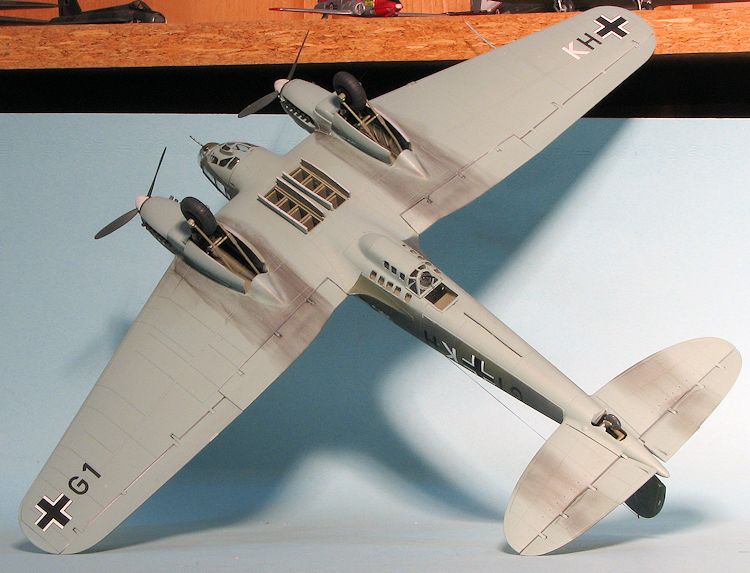 The kit provides separate ailerons, flaps, elevators and rudder. There
are rudder actuating mechanisms to glue in place which will keep the
modeler from posing it other than the neutral position. Each of the
engine nacelles comprises of seven pieces. This version uses stub
exhaust pipes which could be attached at the end of the build to make
painting easier. Included on the sprues are the collector types. All the engine bits are on the same sprue so I would
wager that we can expect the Junkers powered version later. I hope they
provide the right props.
The kit provides separate ailerons, flaps, elevators and rudder. There
are rudder actuating mechanisms to glue in place which will keep the
modeler from posing it other than the neutral position. Each of the
engine nacelles comprises of seven pieces. This version uses stub
exhaust pipes which could be attached at the end of the build to make
painting easier. Included on the sprues are the collector types. All the engine bits are on the same sprue so I would
wager that we can expect the Junkers powered version later. I hope they
provide the right props. | CONSTRUCTION |
 I started by prepainting everything I thought would be RLM 02. Sure,
I'll have to repaint most of the parts after the sprue stubs and mold
seams are removed, but it just seems easier to do things this way. That
being said, I first installed the gunner's station panels into each of
the fuselage halves and then started on a bit of detail painting. Airfix
assumes that everything in there is RLM 02, but I'm sure that the radios
and such would be black so I did that. The pilot and bombardier's seat
were provided with leather seating areas.
I started by prepainting everything I thought would be RLM 02. Sure,
I'll have to repaint most of the parts after the sprue stubs and mold
seams are removed, but it just seems easier to do things this way. That
being said, I first installed the gunner's station panels into each of
the fuselage halves and then started on a bit of detail painting. Airfix
assumes that everything in there is RLM 02, but I'm sure that the radios
and such would be black so I did that. The pilot and bombardier's seat
were provided with leather seating areas. 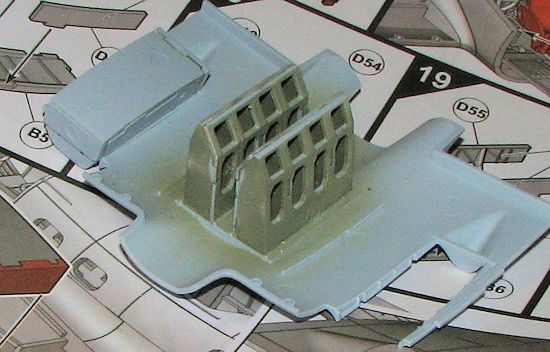 ill
a mounting hole or not, but there isn't one and it is only thanks to the
soft plastic that a good join can be made. Eventually this will fit into a slot in the floor. I also started building up the
wheel wells. These five piece constructs then fit onto a rather
indistinct area on the lower wing center section. The fit here is about
the least positive one I've run across so far. There has to be a more
positive way of locating these. Best way to attach these is to be sure
the glue is still pliable so you can adjust things a bit.
ill
a mounting hole or not, but there isn't one and it is only thanks to the
soft plastic that a good join can be made. Eventually this will fit into a slot in the floor. I also started building up the
wheel wells. These five piece constructs then fit onto a rather
indistinct area on the lower wing center section. The fit here is about
the least positive one I've run across so far. There has to be a more
positive way of locating these. Best way to attach these is to be sure
the glue is still pliable so you can adjust things a bit. 
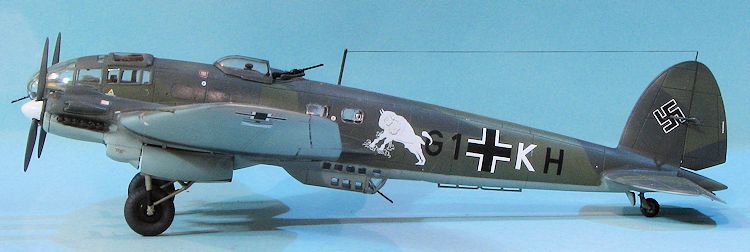 Next, the cockpit transparencies were glued in place. There are three
separate pieces for the main section plus the forward gun piece and the
upper hatch. Fit is fairly good and while one wishes there was another
way of doing it that didn't require so many parts, the end result is
good. For the side windows, I installed the two forward ones on each
side as these are normally painted over. Check references as this was
not always the case. The aft ones as well as the upper gun tub will be
filled with tissue prior to painting.
Next, the cockpit transparencies were glued in place. There are three
separate pieces for the main section plus the forward gun piece and the
upper hatch. Fit is fairly good and while one wishes there was another
way of doing it that didn't require so many parts, the end result is
good. For the side windows, I installed the two forward ones on each
side as these are normally painted over. Check references as this was
not always the case. The aft ones as well as the upper gun tub will be
filled with tissue prior to painting. | COLORS & MARKINGS |
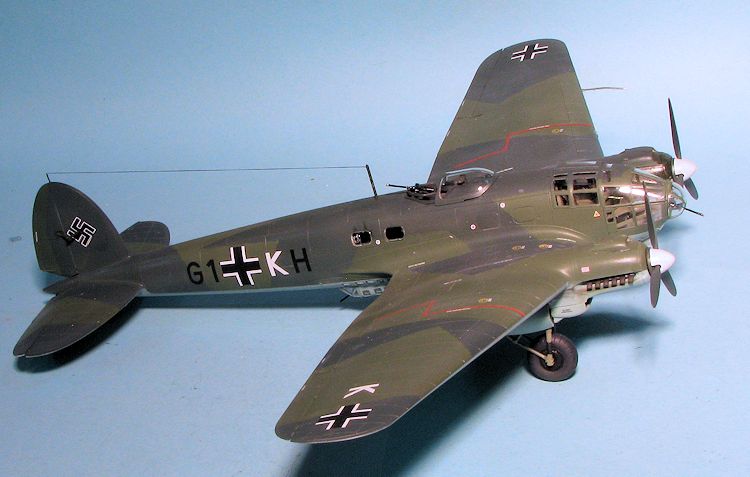 wheel well pieces were mis-numbered
in the instructions. The second is that I got them mixed up. Since I
assembled and installed each well separately, I'm leaning towards the
first issue. This situation was taken care of by cutting the mounting
tabs from the gear legs and super gluing them in place. I found the
other struts fit fairly well, though I had issues getting the long
struts to fit all the way from the back of the wheel well to the main
strut.
wheel well pieces were mis-numbered
in the instructions. The second is that I got them mixed up. Since I
assembled and installed each well separately, I'm leaning towards the
first issue. This situation was taken care of by cutting the mounting
tabs from the gear legs and super gluing them in place. I found the
other struts fit fairly well, though I had issues getting the long
struts to fit all the way from the back of the wheel well to the main
strut. | THE HOME STRETCH |
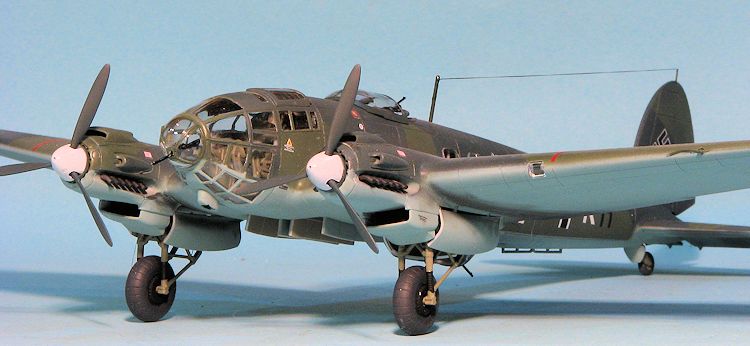 After all the decals were in place, the airframe got a coat of clear
matte. There were still a few more items to install. The upper gun tub
was attached as was the upper radio mast, the lower HF trailing antenna
and the rudder actuator. If you recall, this had to be left off until
after the swastika is installed as the mount runs right through it. The
exhaust were the next items, followed by the main gear doors.
After all the decals were in place, the airframe got a coat of clear
matte. There were still a few more items to install. The upper gun tub
was attached as was the upper radio mast, the lower HF trailing antenna
and the rudder actuator. If you recall, this had to be left off until
after the swastika is installed as the mount runs right through it. The
exhaust were the next items, followed by the main gear doors.| CONCLUSIONS |
| REFERENCES |
https://en.wikipedia.org/wiki/Heinkel_He_111
He-111 in Action, George Punka, 2002.
October 2015
If you would like your product reviewed fairly and fairly quickly, please contact the editor or see other details in the Note to Contributors.